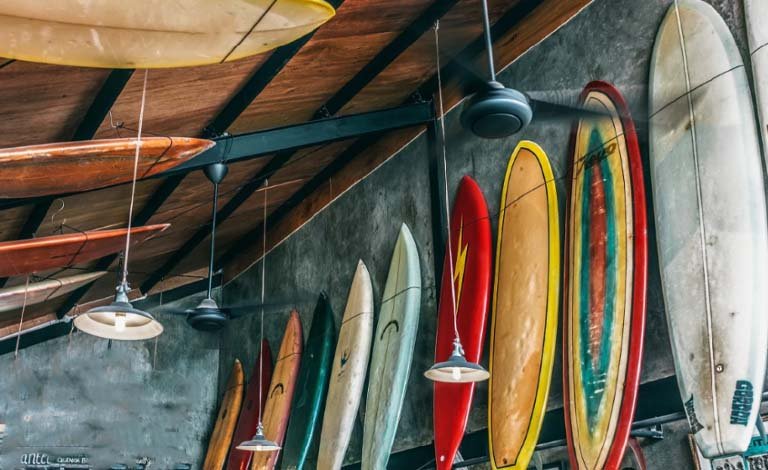As an Amazon Associate I earn from qualifying purchases.
This post contains affiliate links.
Embarking on the journey to find the perfect surfboard is an exhilarating experience for any wave enthusiast. When budget constraints or a desire for variety come into play, learning how to buy a used surfboard becomes a skill worth mastering. With a bit of knowledge and guidance, navigating the second-hand surfboard market can be a rewarding endeavor. In this guide, we’ll unravel the intricacies of how to buy a secondhand surfboard, providing you with the tools and insights needed to make informed decisions and maximize your surfing experience. So, let’s dive into the waves of knowledge and explore the art of buying a used surfboard.

Research, Research, and Research:
Before diving headfirst into the world of used surfboards, take the time to research different board types, shapes, and sizes. Understanding the basics will help you narrow down your options and make an informed decision. Explore various surfing forums, online communities, and resources to gather insights from experienced surfers. Additionally, familiarize yourself with common surfboard terminology such as rocker, rails, and fins, as this knowledge will come in handy during your search.
Set Your Budget:
One of the primary advantages of buying a used surfboard is the potential cost savings compared to purchasing a brand-new board. However, prices can vary widely depending on factors such as the board’s age, condition, and brand. Before beginning your search, determine a budget that aligns with your financial situation and stick to it. Keep in mind that while it’s essential to find a good deal, compromising on quality for the sake of a lower price may result in dissatisfaction down the line.
Where to Look a Used Surfboard:
When it comes to finding a used surfboard, there are several avenues to explore:
Surf Shops: to Buy a Used Surfboard
Many surf shops offer a selection of used surfboard on consignment or through trade-in programs. Visit local shops in your area and inquire about their used surfboard inventory.
Online Marketplaces:
such as Craigslist, Facebook Marketplace, and dedicated surfboard trading websites can be treasure troves for finding used surfboards. Be sure to exercise caution when purchasing online and thoroughly inspect the board before finalizing the transaction.
Surfing Communities:
Engage with local surfing communities, both online and offline, to connect with fellow surfers who may be selling or trading their boards. Surf clubs, meetups, and social media groups are excellent places to start.
Inspecting the Board:
Once you’ve found a potential candidate, it’s crucial to thoroughly inspect the surfboard to assess its condition and suitability:
Check for Damage:
Look for any signs of damage, including dings, cracks, or delamination. Minor cosmetic imperfections may be acceptable, but structural damage can significantly impact the board’s performance and safety.
Assess the Fins and Fin Boxes:
Examine the fin boxes for any cracks or signs of looseness. Ensure that the fins are securely attached and that there are no missing screws.
Evaluate the Deck and Bottom:
Run your hands along the board’s deck and bottom to feel for any soft spots or delamination. These can indicate water damage and compromise the board’s integrity.
Check the Rails and Nose/Tail:
Inspect the rails for any signs of damage or excessive wear. Pay particular attention to the nose and tail, as these areas are prone to impact damage from nosedives and wipeouts.
Test Ride (If Possible):
If the seller allows, take the surfboard for a test ride before making a final decision. Even a brief session in the water can provide valuable insights into the board’s performance, stability, and maneuverability. Pay attention to how the board paddles, catches waves, and turns, and consider how it aligns with your surfing style and skill level.
Negotiate and Finalize the Purchase:
If you’re satisfied with the surfboard’s condition and performance, it’s time to negotiate the final price with the seller. Be prepared to haggle politely but assertively, taking into account any necessary repairs or maintenance costs. Once an agreement is reached, finalize the purchase by completing any paperwork and arranging payment.
Maintenance and Care:
Congratulations, now you have bought this used surfboard so you’re the proud owner of a used surfboard! To ensure its longevity and performance, practice proper maintenance and care:
Rinse After Each Use:
Rinse the board thoroughly with fresh water after each surfing session to remove salt, sand, and debris.
Store Properly:
Store the surfboard in a cool, dry place away from direct sunlight and extreme temperatures. Consider investing in a board bag or rack to protect it from dings and scratches.
Repair Promptly:
Address any minor dings or damage promptly to prevent water from seeping into the board and causing further issues
Wax Regularly:
Apply a fresh coat of surf wax to the board’s deck as needed to maintain traction and grip while surfing.
In conclusion, mastering the process of how to buy a used surfboard opens up a world of possibilities for surfers of all levels. By understanding the key factors to consider, such as board condition, dimensions, and price, you can confidently navigate the second-hand market and find the perfect board to suit your needs and preferences. Remember, thorough research and inspection are crucial steps in ensuring a satisfying purchase. With the knowledge gained from this guide on how to buy a used surfboard, you’re equipped to make informed decisions and embark on countless memorable surfing adventures. So, grab your board, hit the waves, and enjoy the thrill of riding on a budget-friendly, pre-loved surfboard. Happy surfing!
- What Size Surfboard Should I Get as a Beginner?
- How Much Does a Surfboard Cost?
- A Guide to Displaying Your Board with Style
- Finding the Perfect Board for Your Height
As an Amazon Associate I earn from qualifying purchases.
Leave a Reply